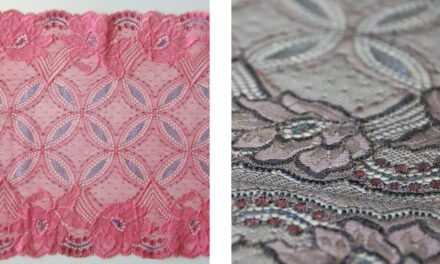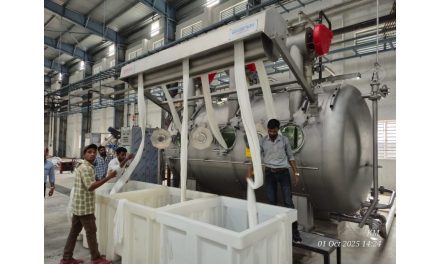 Leading fashion technologist Shima Seiki together with Tokyo-based telecommunications company KDDI Corporation has launched XR Mannequin for APEXFiz, a sales promotion package that links Shima Seiki’s APEXFiz design software for the apparel industry with KDDI’s XR (cross-reality) technology.
Leading fashion technologist Shima Seiki together with Tokyo-based telecommunications company KDDI Corporation has launched XR Mannequin for APEXFiz, a sales promotion package that links Shima Seiki’s APEXFiz design software for the apparel industry with KDDI’s XR (cross-reality) technology.
Using the XR Mannequin that enables viewers to check product images from any angle in 360 degrees on various devices, XR Mannequin for APEXFiz enables digital catalogues with 3D virtual sample image data of garments designed on APEXFiz design software, 360-degree VR showrooms, as well as digitally extended stores. Created for the apparel industry, it also realizes virtual proposals at exhibitions, showroom-style stores with no inventory, and user-friendly purchase experience on e-commerce sites, and more.
It also allows users to reduce excess stock at stores and create new sales opportunities.
Eventually, by adding movement to models wearing Virtual Samples and rendering them on a cloud server, customers will be able to view high-resolution virtual fashion shows on their
smartphones and other devices.
As Shima Seiki points out, until now, the apparel industry has been making actual product samples in each of the planning and design stages of production. This process not only takes an enormous amount of time and cost, but generates waste of raw materials including fabric that require disposal. At the retail stage, stores also needed to have various sizes and colors in stock to address a wide range of customer preferences, resulting in excess inventory.
With Shima Seiki’s APEXFiz, designs can be evaluated without making actual samples, minimizing resources spent on sample production as well as lead time, enabling environmentally-friendly manufacturing.
Background and Aim
• Until now, the apparel industry has been making actual product samples in each of the planning and design stages of production. This process not only takes an enormous amount of time and cost, but generates waste of raw materials including fabric that require disposal. At the retail stage, stores also needed to have various sizes and colors in stock to address a wide range of customer preferences, resulting in excess inventory.
• With SHIMA SEIKI’s APEXFiz, designs can be evaluated without making actual samples, minimizing resources spent on sample production as well as lead time, enabling environmentally-friendly manufacturing.
• In May 2022, KDDI developed a high-resolution XR mannequin for apparel sales, with support from Google Cloud. It enables various devices such as store signages and smartphones to check products from any angle in 360 degrees, enabling stores to sell products without maintaining inventory.
• SHIMA SEIKI and KDDI combines APEXFiz and XR Mannequin to start providing XR Mannequin for APEXFiz. This brings DX solutions to all stages in the supply chain for the apparel industry, from planning and design to sample making, production, distribution, and retail sales.
SHIMA SEIKI and KDDI will continue to create services together that link each other’s products, to bring about a sustainable society by reducing excess stock, and providing a customer experience that gives peace of mind when purchasing products.
Features of XR Mannequin for APEXFiz
 • Virtual Samples created on APEXFiz and distributed with KDDI’s XR Mannequin can be viewed by customers from any angle in 360 degrees, three-dimensionally.
• Virtual Samples created on APEXFiz and distributed with KDDI’s XR Mannequin can be viewed by customers from any angle in 360 degrees, three-dimensionally.
• This way, the seller can communicate product information in AR at the store or in VR in a space created to match product concept, resulting in sales promotion. Links to e commerce sites can also be attached to each product to navigate customers toward purchases.
• Design data created on APEXFiz can be converted into data for WHOLEGARMENT knitting machine production, enabling on-demand production of orders for knitwear generated through use of XR Mannequin for APEXFiz, resulting in production with minimal wasted-resources and minimized stress on the environment.
Scenarios using XR Mannequin for APEXFiz
 (1) Digital catalogs
(1) Digital catalogs
Use of realistic Virtual Samples enables users to create digital catalogs without actual products. Users are able to propose products to customers without maintaining stock at the store and use the catalogs as a sales promotion tool by linking to e-commerce and payment systems. Digital catalogs are based on the free-angle video distribution platform provided by MasterVisions Inc.
(2) 360-degree VR showrooms
Using au XR Door’s web edition, Virtual Samples can be exhibited in a VR space that matches the product concept, to be viewed from any angle in 360 degrees. Showrooms can be displayed anywhere as they are digital, enabling customers to see products anywhere, at any time, even in places which would otherwise be unfit for display in reality.
(3) Digitally extended stores
When customers hold their smartphones in the air inside the store, the camera recognizes the view and displays content and information in specific areas, enabling the seller to extend the store space digitally. Customers unable to visit the store can have a 360-degree VR store space displayed at home to enjoy a similar experience. This enables the seller to promote the store to people overseas and in remote locations to attract customers.
(4) Virtual display with smart glasses
Wearing “Nreal Light” smart glasses, the user will see a Virtual Sample projected three-dimensionally in front of them, allowing the user to walk around the sample 360-degrees. This allows virtual displays without actual products and requiring minimum space.
(5) Product PR and retail enhancement using virtual humans
The virtual human “coh,” an XR Mannequin developed by au VISION STUDIO, is used for product PR and to enhance the retail experience. coh in this image is wearing a virtual WHOLEGARMENT dress.
(6) Checking high-resolution
Virtual Samples through cloud rendering Google Cloud’s Immersive Stream for XR is used to store and distribute high-resolution Virtual Samples in their entirety in a content management system without having to reduce data size, which requires a lot of work in conventional XR content production. Users can enjoy viewing Virtual Samples in VR and AR at the same quality regardless of device performance.
(7) Virtual fashion shows
Virtual fashion shows can be distributed through Immersive Stream for XR, with movement added to models wearing Virtual Samples placed in the desired environment and with meticulous stage direction, enabling customers to enjoy shows interactively in high-resolution through VR and AR from any angle in 360 degrees.
 Leading fashion technologist Shima Seiki together with Tokyo-based telecommunications company KDDI Corporation has launched XR Mannequin for APEXFiz, a sales promotion package that links Shima Seiki’s APEXFiz design software for the apparel industry with KDDI’s XR (cross-reality) technology.
Leading fashion technologist Shima Seiki together with Tokyo-based telecommunications company KDDI Corporation has launched XR Mannequin for APEXFiz, a sales promotion package that links Shima Seiki’s APEXFiz design software for the apparel industry with KDDI’s XR (cross-reality) technology.

 • Virtual Samples created on APEXFiz and distributed with KDDI’s XR Mannequin can be viewed by customers from any angle in 360 degrees, three-dimensionally.
• Virtual Samples created on APEXFiz and distributed with KDDI’s XR Mannequin can be viewed by customers from any angle in 360 degrees, three-dimensionally. (1) Digital catalogs
(1) Digital catalogs























